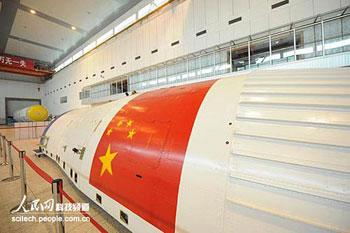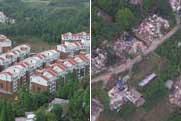China
How the Long March II-F rocket works
WATCH VIDEO
Source: CCTV.com | 09-25-2008 16:44
Special Report: Shenzhou-7 Manned Space FlightThe Long March II-F rocket is the most intricate and reliable rocket in China. As the only rocket to launch a manned space flight, it represents the country's most advanced space technology.
 |
| The Long March II-F rocket |
This is the Long March propelling rocket which will send the Shenzhou 7 space flight into orbit.
It weights nearly five hundred tons, but 90 percent of the weight comes from liquid fuel.
To reduce the air resistance, all of the fuel boxes will be discarded after the fuel is used. The escape tower and cowling piece are also discarded after they finish their tasks.
Duan Zengbin, Deputy Chief Designer of Long March propelling rocket project, said, "If the rocket doesn't discard them, it makes flying very difficult. Throwing them away helps the rocket fly faster."
Consisting of one-stage and two-stage rockets, the Long March II-F rocket will fly less than 10 minutes in its mission.
Jing Muchen, Chief Designer of Long March propelling rocket project, said, "The rocket's flying process will be divided into two parts: the first-stage flying and second-stage flying. In the first stage, the rocket will fly upright in the first ten seconds, then it will turn on an angle and then keep flying along this angle. This will save fuel and energy."
After two minutes in the air, if everything goes as planned, the rocket will discard the escape tower.
20 seconds later, the boosters will have used up fuel and separate from the body of the rocket. After another 20 seconds, the first stage-rocket will have used up its fuel and detach from the second-stage rocket.
At about 200 seconds, the second-stage rocket propels out of the atmosphere. The cowling piece, which protects the spaceship from air friction, is then cast away as it is no longer needed.
At about 10 minutes into flight, the rocket will have reached its orbit, and separate from the space module.
Jing Muchen, Chief Designer of Long March propelling rocket project, said,"The rocket will fly through six provinces, so people there may see it with their eyes or by telescope. When the rocket departs from the spaceship,people will see a shining point, and that is the debris of the second-stage rocket. It will continue on its path and then enter the atmosphere and disassemble. "
Scientists have calculated that the rocket debris will fall on desert or grassland. After safely falling to the ground, the rocket will have completed its task.
Liu Yu, Jing Muchen, Director of Long March propelling rocket project, said, " When we count down the launch, we will say goodbye to the rocket. We call it a brave knight. We hope it can fly to its goal and we know it will never retreat. "
Designed in 1990s, the Long March 2-F rocket has been successfully used in six space flights, including two manned space missions. The Shenzhou 7 launch will be its last mission. Though this series of rocket will retire soon, it will long be remembered for its contributions China's space program.
| Comment
|
Interactive: Be part of China's journey to space!
Editor:Zhang Pengfei



